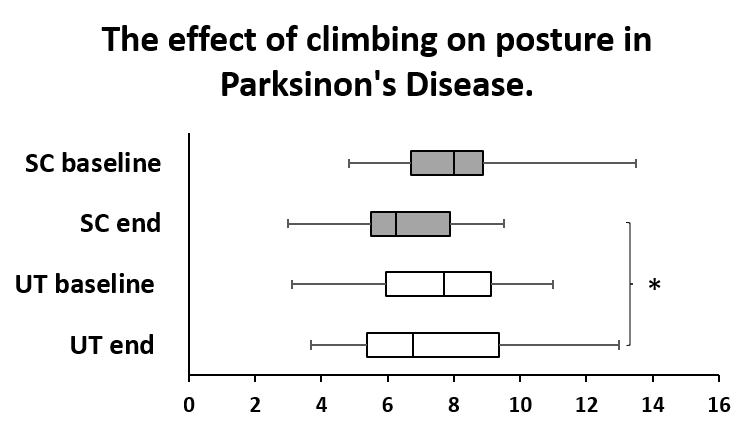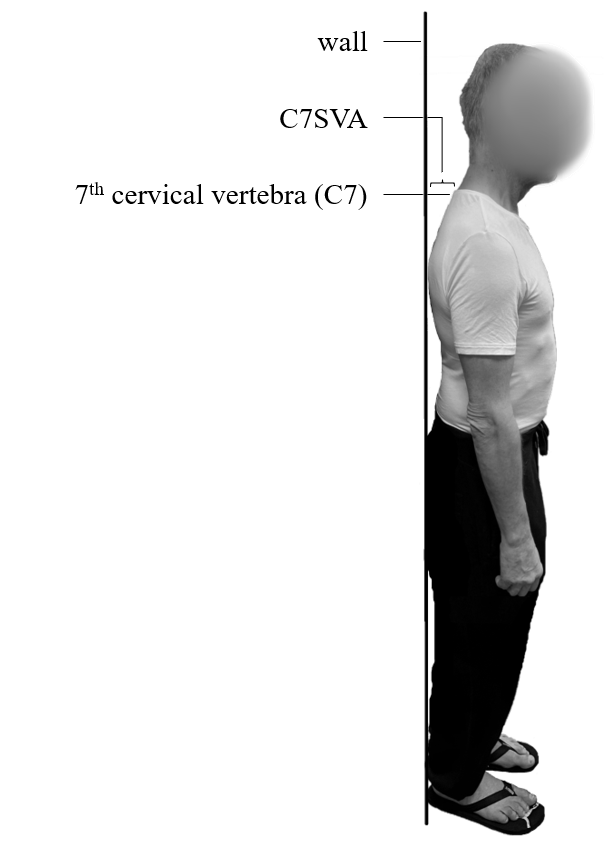Category: Parkinson’s Disease: Clinical Trials
Objective: We investigated the role of sport climbing in correcting stooped posture in Parkinson Disease patients.
Background: Parkinson’s Disease (PD) is a neurodegenerative movement disorder often associated with stooped posture with forward flexion of the trunk. Pharmacological treatment response is generally poor, and exercise and physical therapy are the treatment of choice.
Method: This was a randomised semi-blind trial of 12 weeks duration, investigating an intervention group, “sport climbers” (SC) and a control group, “unsupervised activity” (UT). SC followed a 12-week, 90 min/week supervised top-rope sport climbing course
We included patients with mild to moderate idiopathic PD (Hoehn & Yahr (H&Y) stage 2-3), diagnosed according to the UK Brain bank criteria without prior climbing experience
To assess posture, the distance (in cm) of the seventh cervical vertebra (C7) sagittal vertical axis (C7SVA) from the wall was defined when standing upright against a wall.
All assessments at baseline (BASE) and after 12 weeks at the end of the intervention (END) were performed in the patients’ best ON-state.
Results: 48 patients were included in the study. Of those, 46 were included in the analysis due to two drop outs in the SC group (see table 1 for patient characteristics).
At baseline, the mean C7SVA did not significantly differ between the two groups (SC: 8.2cm, 95%CI[7.3, 9.2], UT: 7.7cm; 95%CI[6.8, 8.6], mean difference 0.5cm, 95%CI[-0.7, 1.8]). Within a period of 12 weeks, there was a significant improvement of C7SVA in the SC(-1.7cm (95%CI[-2.6, -0.8]), but not in the UT group (-0.5cm; 95%CI[-1.3, 0.2,]; table 2 and figure 2). According to the regression model, change in C7SVA over 12 weeks was significantly associated with being part of the SC vs the UT (coeff. 1.2; p=.044); see table 2.
Conclusion: In this randomised controlled trial, we investigated the effect of sport climbing on the stopped posture of PD patients and demonstrated that sport climbing significantly decreases forward flexion of the cervical spine in PD patients.
This study provides Class I evidence that sport climbing improves stooped posture in mild to moderate Parkinson Disease.
A variety of mechanisms, including increase in trunk muscle strength, stretching of shortened muscles, improvement of proprioception, and cognitive effects may contribute to this effect.
To cite this abstract in AMA style:
A. Langer, D. Roth, A. Santer, A. Flotz, J. Gruber, L. Wizany, S. Hasenauer, R. Pokan, P. Dabnichki, M. Treven, S. Zimmel, M. Schmoeger, U. Willinger, L. Gassner, W. Maetzler, H. Zach. Climb up! Head up! Climbing improves posture in Parkinson’s disease. A randomised controlled trial. [abstract]. Mov Disord. 2022; 37 (suppl 2). https://www.mdsabstracts.org/abstract/climb-up-head-up-climbing-improves-posture-in-parkinsons-disease-a-randomised-controlled-trial/. Accessed January 5, 2026.« Back to 2022 International Congress
MDS Abstracts - https://www.mdsabstracts.org/abstract/climb-up-head-up-climbing-improves-posture-in-parkinsons-disease-a-randomised-controlled-trial/


